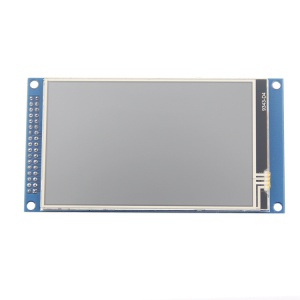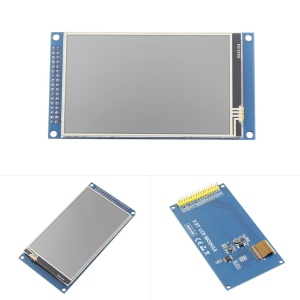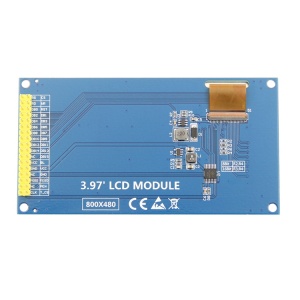More actions
Product Video
Product Picture
Product Description
- 3.97-inch color screen, support 16BIT RGB 65K color display, display rich colors
- 800x480 resolution for clear display
- 16-bit parallel bus transmission for fast transfer speed
- Supports ALIENTEK STM32 Mini, Elite, WarShip, Explorer, and Apollo development boards for direct plug-in use
- Support for touch function
- Support SD card function expansion
- Provides a rich sample program for STM32 and C51 platforms
- Military-grade process standards, long-term stable work
- Provide underlying driver technical support
Product Parameters
| Name | Parameter |
| Display Color | 16BIT RGB 65K color |
| SKU | MRB3973 |
| Screen Size | 3.97(inch) |
| Type | TFT |
| Driver IC | NT35510 |
| Resolution | 800*480 (Pixel) |
| Luminance | 330Cd/m2 |
| Module Interface | 16Bit parallel interface |
| Active Area | 51.84x86.40(mm) |
| Module PCB Size | 59.18x111.51(mm) |
| Operating Temperature | -10℃~60℃ |
| Storage Temperature | -20℃~70℃ |
| Operating Voltage | 3.3V/5V |
| Power Consumption | 0.97W |
| Product Weight(Package containing) | 63g |
Interface Definition
The module hardware supports 8-bit and 16-bit parallel port data bus mode switching (as shown by the red box in Picture 1 above), as follows:
- Solder R3 and R4 with 0Ω resistor or short circuit directly, and disconnect R2 and R6: select 16-bit data bus mode (default), use DB0~DB15 data pin
- Solder R2 and R4 with 0Ω resistor or short circuit directly, and disconnect R3 and R6: select 8-bit data bus mode, use DB0~D7 data pin
| Number | Pin Label | Description |
| 1 | CS | LCD reset control pin( low level enable) |
| 2 | RS | LCD register / data selection control pin(high level: register, low level: data) |
| 3 | WR | LCD write control pin |
| 4 | RD | LCD read control pin |
| 5 | RST | LCD reset control pin( low level reset) |
| 6 | DB0 | LCD data bus low 8-bit pin |
| 7 | DB1 | |
| 8 | DB2 | |
| 9 | DB3 | |
| 10 | DB4 | |
| 11 | DB5 | |
| 12 | DB6 | |
| 13 | DB7 | |
| 14 | DB8 | LCD data bus high 8-bit pin |
| 15 | DB9 | |
| 16 | DB10 | |
| 17 | DB11 | |
| 18 | DB12 | |
| 19 | DB13 | |
| 20 | DB14 | |
| 21 | DB15 | |
| 22 | NC | Undefined, reserved |
| 23 | BL | LCD backlight control pin(High level light) |
| 24 | VCC | Module power positive pin (module has integrated voltage regulator IC, so the power supply can be connected to 5V or 3.3V) |
| 25 | VCC | |
| 26 | GND | Module power ground pin |
| 27 | GND | |
| 28 | NC | Undefined, reserved |
| 29 | MISO | Touch screen SPI bus data input pin |
| 30 | MOSI | Touch screen SPI bus data output pin |
| 31 | PEN | Touch screen interrupt detection pin(Low level when a touch occurs) |
| 32 | NC | Undefined, reserved |
| 33 | T_CS | Touch screen IC chip select control pin(Low level enable) |
| 34 | CLK | Touch screen SPI bus clock control pin |
Product Documentation
- 3.97inch 16bit Parallel-Port Module User Manual
- 3.97inch TFTLCD Specification
- 3.97inch 16bit Parallel-Port Module Size Picture
- 3.97inch 16bit Parallel-Port Module Schematic
- 3.97inch 16bit Parallel-Port Module LCD Schematic and PCB Package Library
- Driver IC NT35510 Data sheet
Program Download
Reference Materials
- C51 Keil and stc-isp software use illustration
- STM32 keil software use illustration
- PCtoLCD2002 software use illustration
- Image2Lcd software use illustration
- Chinese and English display modulo settings
How to use on STM32 development board
This module is compatible with the ALIENTEK STM32 development board. The specific usage is as follows:
- Step 1: Download the test program
- Download the STM32 Mini development board IO emulation or other development board FSMC test program from the Program Download column (only these programs support the STM32 development board in-line)
- You can also download the standard routines that come with the punctual atomic STM32 development board
- For a description of the relevant test procedures, please refer to the test program documentation in the package
- Step 2: Connect the STM32 development board
- Find the TFTLCD interface on the development board, connect the module pins and interfaces, and then plug them directly into
- the interface(for the connection method, please refer to the instructions of the ALIENTEK STM32 development board)
- Step 3: Compile and download the program to the development board
- Compile and download the program you need to test to the STM32 development board( Don't know how to compile and download?)
- Step 4: Observe the running of the program
- After the program is finished, observe the running status of the program. If it can be displayed normally, the program runs successfully.




